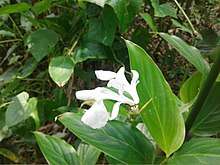Schumannianthus dichotomus
Schumannianthus dichotomus,[2] also known as 'cool mat', was first described by Roxburgh, with its current name after Gagnepain. The plant belongs to the family Marantaceae and no subspecies are listed.[3][4]
| Schumannianthus dichotomus | |
|---|---|
 | |
| Scientific classification | |
| Kingdom: | Plantae |
| Clade: | Tracheophytes |
| Clade: | Angiosperms |
| Clade: | Monocots |
| Clade: | Commelinids |
| Order: | Zingiberales |
| Family: | Marantaceae |
| Genus: | Schumannianthus |
| Species: | S. dichotomus |
| Binomial name | |
| Schumannianthus dichotomus | |
| Synonyms[1] | |
| |
S. dichotomus is typically found in muddy riparian areas; it is known as Pati Doi in Assamese and Murta in Sylheti, Mostak, Pati bet patipata and paitara in Bengali; in Vietnamese it is called lùm nước
Description

It is a rhizomatous plant with an erect and glossy green stem attaining a height of 3–5 m and a diameter of up to 20 mm. The stems are leafy and dichotomously branched.[5]
Distribution
Geographically it is distributed in northeast Bangladesh, West Bengal, Assam, Burma, Thailand, Cambodia, Vietnam, Peninsular Malaysia, Borneo and the Philippines.[6] In India it is found in riverine areas like Majuli island in Assam, and Comilla, Tangail; in Bangladesh the plant is found especially in the swamp forests of Sylhet[7] and is cultivated mostly in the districts of Sylhet, Sunamganj, Barisal, Tangail, Comilla, Noakhali, Feni and Chittagong.
Uses
The plant used for making the Shital pati[8] a traditional bed mat in Eastern India and Bangladesh. Traditional artisans make strips from the outer portion of the stem including the epidermal part. These split strips are processed and plaited into mats. Murta splits are also used for making prayer mats, baskets, bags, novelty items, etc. The strips from the pith portion are used as binding materials.
Forestry Master Plan (1982) of Bangladesh estimates that about 8,000 people are employed in sitalpati making in the country. Swampy and marshy lands are suitable for murta cultivation. Traditionally it is propagated through rhizomes, but can be also propagated through branch cuttings. The propagules are planted during the months of May–June. After planting it takes 2–3 years to reach the harvestable size. February–March is the harvesting period. It can also be propagated through seeds. It grows well in partial shade. So, farmers often plant Erythrina trees in murta fields. It needs no special management other than weeding.
In the traditional production of Tungrymbai, an Indian fermented soybean food, the leaves are packed together with boiled soybeans.
References
- "The Plant List: A Working List of All Plant Species".
- Gagnepain (1904) In: Bull. Soc. Bot. France 51: 176
- Roskov Y.; Kunze T.; Orrell T.; Abucay L.; Paglinawan L.; Culham A.; Bailly N.; Kirk P.; Bourgoin T.; Baillargeon G.; Decock W.; De Wever A. (2014). Didžiulis V. (ed.). "Species 2000 & ITIS Catalogue of Life: 2014 Annual Checklist". Species 2000: Reading, UK. Retrieved 26 May 2014.
- WCSP: World Checklist of Selected Plant Families
- Romel Ahmed; A. N. M. Fakhrul Islam; Mostafizur Rahman & Md. Abdul Halim (2007). "Management and economic value of Schumannianthus dichotoma in rural homesteads in the Sylhet region of Bangladesh". International Journal of Biodiversity Science & Management. 3 (4): 252–258. doi:10.1080/17451590709618178.
- "World Checklist of Selected Plant Families".
- Hossain, Ashfaq (2012). "Sylhet District". In Islam, Sirajul; Jamal, Ahmed A. (eds.). Banglapedia: National Encyclopedia of Bangladesh (Second ed.). Asiatic Society of Bangladesh.
- Banu, Zinat Mahrukh (2012). "Nakshi Pati". In Islam, Sirajul; Jamal, Ahmed A. (eds.). Banglapedia: National Encyclopedia of Bangladesh (Second ed.). Asiatic Society of Bangladesh.